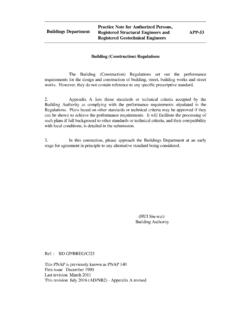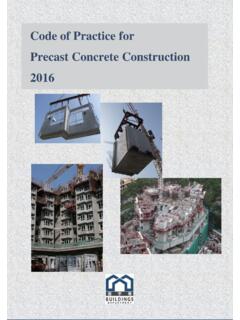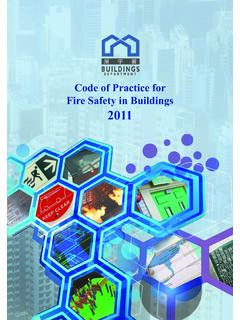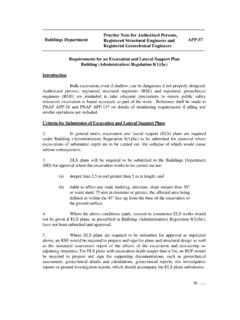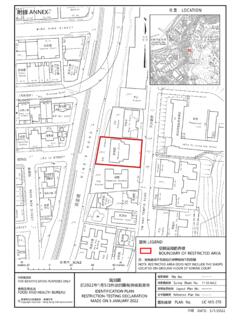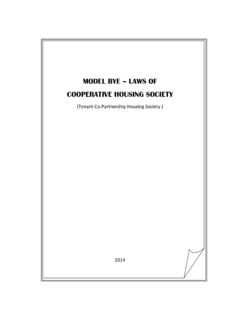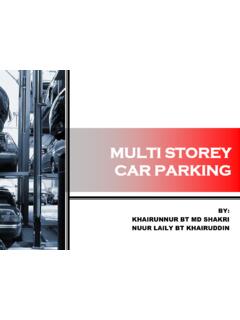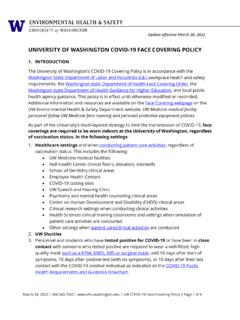Transcription of Code of Practice on Wind Effects in Hong Kong 2019
1 Code of Practice on wind Effects in hong kong 2019 Code of Practice on wind Effects in hong kong 2019 FOREWORD This Code of Practice on wind Effects in hong kong 2019 (Code) was prepared on the basis of a consultancy study commissioned by the Buildings Department under the direction of a Steering Committee. The Steering Committee of the consultancy included members from the academia, professional institutions and relevant government departments. The new features introduced in this Code are: (a) Calculation of across- wind and torsional forces (b) Load combination factors for lateral and torsional forces for buildings (c) Calculation of the direct sheltering effect of surrounding buildings, using the concept of displacement height to reduce the effective height of buildings for assessing reference wind pressures and force coefficients (d) Calculation of acceleration and evaluation of occupant comfort (e) wind directionality factor accounting for the reduced probability of strong winds from various directions This Code also provides information on.
2 (a) Force and pressure coefficients for design of typical buildings in hong kong (b) An updated vertical distribution of along- wind forces, through a size and dynamic factor which increases with height (c) Guidance for the design of building attachments (d) Further guidance on requirements for wind tunnel testing As the Code has been prepared in a simple format for ease of application, reference should be made to the Explanatory Notes to the Code (EN), which give a summary of background information and considerations reviewed in the formulation of the Code. The EN also explains in depth the major updates and features in the Code and to address on situations where application of the Code may require special attention. The contributions on the formulation of the Code by the members of the Steering Committee are greatly appreciated.
3 Acknowledgement is given to the hong kong Observatory as the source of the cloud imagery on the cover page. The cloud imagery was originally captured by Himawari-8 Geostationary Meteorological Satellite of Japan Meteorological Agency. This Code will be reviewed regularly. The Buildings Department welcomes suggestions for improving the Code. Buildings Department First Issue : September 2019 Page I Contents Page FOREWORD I Contents II 1 General 1 Scope 1 Symbols 1 2 Calculation of wind Actions 5 Procedure for Calculating wind Forces 5 wind Forces on Buildings 8 wind Forces on building Elements 14 wind Acceleration of Buildings 15 Minimum wind Loads for Temporary Structures 16 3 Design wind Pressures 17 General 17 wind Reference Pressure at Effective Height 17 Sheltering Effects 18 Topography Effects 18 4 Force and Pressure Coefficients 19 General 19 Force Coefficients for Buildings 19 Pressure Coefficients for building Elements 24 5 Size Factor and Size and Dynamic Factor 30 Size Factor 30 Size and Dynamic Factor
4 For Buildings 32 6 Requirements for wind Tunnel Testing 33 General Requirements 33 Target Reliability for Loads 36 Additional Requirements for Cladding 36 Minimum Loads in Sheltered Locations 36 Code wind Pressures and Treatment of wind Directionality 37 Requirements for Verification 38 Page II Appendix A Supplementary Information for Section 3: Design wind Pressures A1 wind Climate wind Directionality wind Pressure with Selected Return Periods for Acceleration Calculation A2 Exposure Adjustment for Direct Shelter A3 Topographic Multiplier Appendix B Supplementary Information for Section 4: Force and Pressure Coefficients B1 Pressure Coefficients for building Envelope with Dominant Openings Definition of Dominant Opening External Pressure Coefficients for building Envelope Internal Pressure Coefficients for building Envelope with Dominant Openings B2 Pressure Coefficients for building Attachments Sunshades, Architectural Fins and Signboards Balconies Canopies Attached to Buildings B3 Pressure Coefficient for Free-standing Walls Appendix C Supplementary Information for Section 5.
5 Size Factor and Size and Dynamic Factor C1 Equations for Calculation of Size Factor C2 Damping of Buildings and Other Structures Page III List of Tables Table 2-1 Load combination factors for buildings that may be treated as rectangular Table 3-1 wind reference pressure, Qo,z Table 4-1 Net pressure coefficients for an enclosed building envelope without dominant openings, Cp Table 4-2 Net pressure coefficients for open frameworks Table A1-1 Directionality factor on pressure, S Table A1-2 Return period factor on pressure, Sr Table B1-1 External pressure coefficients for building envelope with dominant openings, Cpe Table B1-2 Internal pressure coefficients for building envelope with dominant openings, Cpi Table B2-1 Net pressure coefficients for sunshades, architectural fins and signboards Table B2-2 Net pressure coefficients for balcony slabs, balcony walls and balustrades, Cp Table B3-1 Net pressure coefficient for free-standing walls Table C2-1 Damping ratio for typical RC buildings, x , y Table C2-2 Damping ratio for typical steel buildings, x , y Page IV List of Figures Figure 2-1 Flow-chart for wind actions on structure Figure 2-2 Flow-chart for wind actions on building elements Figure 2-3 Definition of variable torsion Figure 2-4(a) Co-ordinate system for along- wind and across- wind actions -Lateral loading Effects due to wind from direction X1 Figure 2-4(b)
6 Co-ordinate system for along- wind and across- wind actions -Lateral loading Effects due to wind from direction X2 Figure 2-5 Co-ordinate system for wind forces Figure 2-6 Acceptable occupant comfort level Figure 4-1 Basic definitions of building plan dimensions Figure 4-2 Force coefficient for simple rectangular prismatic shaped building , Cf Figure 4-3 Basic dimensions for considering corner Effects Figure 4-4(a) Basic dimensions for U-shaped buildings Figure 4-4(b) Basic dimensions for X-shaped buildings Figure 4-4(c) Basic dimensions for double Y-shaped buildings Figure 4-4(d) Basic dimensions for single Y-shaped buildings Figure 4-4(e) Basic dimensions for single L-shaped buildings Figure 4-4(f) Basic dimensions for single Z-shaped buildings Figure 4-5(a) wind reference height and zone scaling dimensions for a tower set back from edge of podium Figure 4-5(b) wind reference height and zone scaling dimensions for tower at podium edge Figure 4-6(a) Zone key for pressure Figure 4-6(b) Dimensions for pressure zones in Figure 4-6(a) Figure 5-1 Half perimeter of the loaded area, Figure 5-2 Size factor, Ss Figure 5-3 Half-perimeter of the loaded area, , due to several openings contributing to the dominant opening area, Ao Figure 6-1 Minimum adopted wind loads from a test Figure A2-1 Plan showing 45 degrees of the considered wind direction Figure A2-2 Definition of Hi and Xi (on elevation)
7 Figure A2-3 Variation of Hdi/H with Xi/H and Hi/H Figure A2-4 Variation of building height across sector (a demonstration case on plan with four unequal divisions) Page V Figure A3-1(a) Definition of topographic dimensions for hills and ridges Figure A3-1(b) Definition of topographic dimensions for cliffs and escarpments Figure A3-2(a) Topographic location factor, s, for upwind section for both hills / ridges and cliffs / escarpments (significant zone in orange colour in Figure A3-1(a) and Figure A3-1(b)) Figure A3-2(b) Topographic location factor, s, for downwind section for hills and ridges (significant zone in blue colour in Figure A3-1(a)) Figure A3-2(c) Topographic location factor, s, for downwind section for cliffs and escarpments (significant zone in blue colour as defined in A3-1(b))
8 Figure B1-1 wind pressure on external walls due to dominant opening Figure B1-2 wind pressure on internal walls due to dominant opening not located in corner Figure B1-3 wind pressure on internal walls due to dominant opening located in upwind corner Figure B1-4 wind pressure on internal walls due to dominant opening located in downwind corner Figure B2-1 Sunshades, architectural fins and signboards Figure B3-1 Pressure zone definition for free-standing walls Page VI 1 General Scope The Code of Practice on wind Effects in hong kong 2019 (Code) stipulates the approach for calculating the wind loads for the structural design of buildings or parts of buildings, referred hereinafter as Standard Method.
9 Compliance with the requirements of this Code is deemed to satisfy the relevant provisions of the Buildings Ordinance and related regulations. Values of wind loads for use in design shall be established. The values shall be appropriate for the type of structure or structural element, its intended use, design working life and exposure to wind loads. The Standard Method is intended to cover normal building constructions. Users of this Code should satisfy themselves that the guidance is rationally applicable to the form of structure under consideration. The Standard Method is applicable to typical buildings with a height up to 200m. The wind tunnel testing method should be used for any of the following conditions: (a) buildings of height exceeding 200m; (b) buildings having an unusual shape not covered by this Code; (c) buildings in locations where complicated local topography or surroundings adversely affect the wind conditions; (d) buildings with codified across- wind moment substantially larger than the along- wind moment as detailed in clause ; or (e) buildings with B/D>6, except for those satisfying the conditions in clause so that the torsional load cases can be neglected.
10 Guidance for wind tunnel testing is provided in Section 6. Symbols The symbols used in this Code shall have the following meanings with respect to a structure, member or condition to which a clause is applied. Except where specifically noted, this Code uses the SI units. Angles are given in degrees. For subscripts, lower case letters are used. Page 1 z peak acceleration at height Z (m/s2) breadth of building , the horizontal dimension of the building normal to the direction of the wind scaling length defining loaded areas for pressure coefficients, taken as the smaller of B or 2H force coefficient determined in accordance with Section 4 net pressure coefficient, or total pressure coefficient for building elements external pressure coefficient internal pressure coefficient depth of building , the horizontal dimension of the building parallel to the direction of the wind diameter of circular cylinder 1, 2 eccentricity for calculating variable torsional load 1, 2 along- wind forces 1, 2 across- wind forces peak factor on standard deviation of across- wind resonant response in one hour = 2 (1800 )
